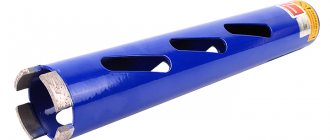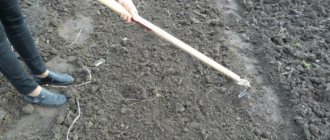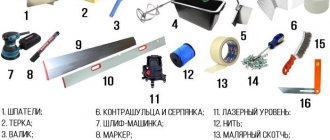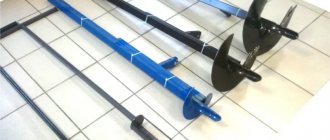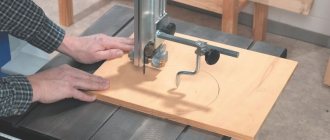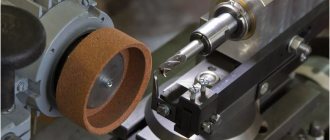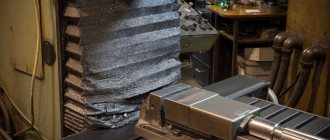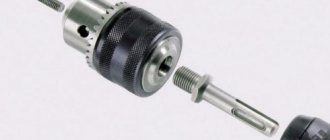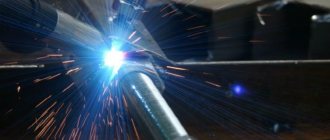A plane is a traditional carpenter's tool, a kind of symbol of this profession. The shape of the instrument and the methods of working with it, despite its technical improvement over many years, have not essentially changed.
In order for the process of planing a wooden workpiece to proceed “without a hitch” (as evidenced by the twisted shavings freely coming out of the slot in the plane block), it is necessary to accurately adjust the plane knife and correctly move the plane along the surface being planed.
Planing is a real pleasure when thin and long twisted shavings fly out of the plane.
Having fixed the plane knife with the chipbreaker exposed in the vice of the workbench, lightly tighten the screw. After wedging, the chipbreaker fixes itself due to its springiness.
Insert the knife into the tap hole of the plane and first secure the wedge in its guides by hand.
To determine whether the knife is positioned correctly (its blade should be parallel to the plane of the sole of the plane and slightly protruding above it), you simply need to turn the plane over and evaluate the mutual parallelism of the knife blade and the sole by eye. To adjust (if necessary) the position of the knife, release the wedge, align the knife correctly and fix it again with the wedge.
When planing the faces of workpieces, the knife should remove chips of uniform thickness. To do this, you need to adjust the chipbreaker of a jointer, a double plane (with a double blade) or a sander. The chipbreaker performs the function corresponding to its name and should be installed slightly above (about 1 mm) the knife blade and fit snugly against it.
First, the knife with the chipbreaker fixed on it is inserted into the slot (tap) of the block (body) and slightly wedged. Then set the knife with light blows of the hammer so that its blade is parallel to the sole of the plane and protrudes slightly above it. After this, the knife is finally fixed in the block with a wedge, screw or cam clamp (depending on the design of the plane).
Since during planing the upper part of the worker’s body moves together with the plane, the carpenter must stand on the side parallel to the workpiece being processed, with one leg placed forward. To prevent the plane from tipping over at the beginning and end of the workpiece (then the surface being processed in these areas will be uneven), you should lean harder first on its front handle, and then on the back handle at the exit.
PRECISION PLANE
In modern planes with a metal block, the blade is usually secured with a screw. With another screw (set screw), you can adjust the plane to the required thickness of the chips being removed with an accuracy of hundredths of a millimeter. In addition, such planes are equipped with a so-called knife tilt regulator, which allows you to quickly, just by pressing the thumb on the corresponding lever, correctly position the knife blade relative to the sole of the plane.
EDGE PLANING
When planing the edges of flat workpieces, you should move the plane along an even path along the entire length of the workpiece, leaning evenly on it. In this case, the knife must be secured securely so that it does not vibrate in the block. In addition, you should avoid tearing the chips by cutting in the direction of the wood grain. When processing wood pieces with thin and irregular texture (for example, root), the knife must be sharpened very well. When planing, such a workpiece should be constantly rotated.
It is more convenient to plan a narrow edge using, for example, a piece of board pressed against the workpiece, or plan simultaneously the edges of several thin boards collected in a package. In this case, the supporting surface for the sole of the plane increases.
To prevent the edge from becoming rounded, the plane must be held level, without tilting in any direction.
With Sherhebel you can remove a thicker layer of material in one pass.
Planing the end of the workpiece will be much easier if you hold the plane at an angle to the faces of the workpiece.
Wide wooden overlays, attached with a clamp to both edges of the workpiece, will prevent chipping when processing the end.
The surfaces of short-length workpieces are very smooth with a silky shine after processing with just a sander.
When planing layers, it is necessary to constantly check their processed surface with a steel square.
When processing long workpieces, a jointer has proven itself best, as it can be used to plane even against the grain.
PLANING PLATES
To make a rough but even surface smooth, it is enough to treat it with a sander (a tool with a knife angle increased to 60° for fine planing of hard-to-cut wood) and a jointer. To eliminate unevenness or remove a thicker layer, treatment with Sherhebel will be required. The latter is equipped with a narrow (33 mm wide) convex knife with an oval blade, capable of removing chips up to 3 mm thick in one pass. After this, the surface must be leveled with a sander and “smoothed” with a jointer.
CLEANING THE ENDS
When cleaning the ends of the workpieces, the plane is driven in the direction “away from you”, making short pushes with it. In this case, the wood fibers are cut crosswise, which requires somewhat greater effort and the use of a very sharp knife. To avoid chipping at the edge in the direction in which the end of the workpiece is being machined, you can first chamfer this edge. It’s better to first process one half of the end to the middle, and then, turning the workpiece 180°, the second half.
More than during operation, the blades deteriorate from contact with foreign objects when the plane is not used. During breaks in work, the plane should be placed on its side or with the front of the sole on a wooden stand. During long-term storage or when transporting the plane in a tool box, the knife should be placed inside the block.
Source: niola-td.ru
How to choose and use an electric planer correctly
An electric plane is an essential tool for anyone who deals with wood processing, and during construction or renovation it can become an indispensable assistant. In everyday life, a traditional hand plane is usually enough for a home craftsman, but in a private farmstead or summer cottage there is plenty of woodworking. Baths, outbuildings, fences, benches and other furniture - the list goes on and on.
An electric planer will save the craftsman a lot of time and effort and allow him to achieve good results. Using an electric planer, workpieces are brought to the required dimensions, surfaces are leveled, nicks, burrs and knots are removed, edges are cut, and grooves are selected. A plane, of course, is not capable of “fine” processing of surfaces to perfect smoothness; this will require additional tools. But with its main task - rough processing of wood in large volumes - the electric planer, if the operating rules are followed, copes “excellently”.
As when choosing any power tool, when choosing an electric planer, a master should start from the main tasks in which the tool will be most often involved. An important role is played by the power of the tool, which is directly related to its performance. A plane of greater power plans “deeper”, that is, it can remove a thicker layer of wood in one pass. Manual electric planers are produced with a power ranging from 0.5 to 2.2 kW. Above one and a half kilowatts is, in fact, a professional tool for large-scale work. If you plan to use the plane frequently and in large volumes, it makes sense to take a closer look at more powerful models. But, as always, the rule applies: the more powerful the tool, the more it weighs and the higher its price. It will be convenient to work with a low-power plane while suspended. Medium power models weigh between 2.5-4 kg.
Another indicator is the rotation frequency of the drum, that is, the number of revolutions it makes per unit of time. This value is very important to consider when choosing a plane, says FORUMHOUSE wind1wind: the higher the number of revolutions, the better the quality of the cut. The optimal option that you should focus on when choosing is 15000-16000 rpm.
wind1wind:
– The plane does not create a completely flat surface, but a “wave” with very fine steps. To make this waviness invisible, the number of shaft revolutions and the number of knives on the shaft are increased. These two parameters are very important when choosing.
What is a plane needed and intended for?
A wood planer performs a fairly extensive range of tasks - not just planing to a flat surface.
Planing a board
The following works are possible:
- creating a groove and groove of the desired shape;
- quarter selection (specialized cutout along the edge of the part);
Quarter selection and chamfering
- creating a chamfer or changing its shape and geometry;
- facing and trimming the workpiece;
- creation and processing of flat surfaces to the required dimensions and parallelism;
- bringing the surface roughness to the required value, eliminating waviness.
With a plane you can process workpieces for roughing, finishing and finishing, and finish finished surfaces. The tool is widely used in woodworking in the following areas:
- creation and repair of furniture;
- construction (doors, windows, baseboards, trim);
- restoration work on art and antiquities.
Wherever wood and lumber are processed, a plane will be useful.
Its modern version, the electric planer, is used both at home and professionally. Processing with its help is faster and requires less muscle power. The device is perfectly mechanized - there are many structural adjustments and the ability to install a vacuum cleaner.
How to work with an electric planer correctly?
Many beginners are interested in the question of how to work with an electric planer. At first glance, there is nothing complicated: plug it into a power outlet, press a button, move it back and forth across the surface, removing chips. However, during the first attempts, the result is not always impressive.
When purchasing a tool, you need to check its functionality, completeness and appearance. It is worth paying attention to the sharpening quality of the installed knives. If the kit contains spare knives, you need to check them too. The cutting edge should be smooth, sharp, without gouges or bends. All other settings should be checked at home in accordance with the manufacturer's instructions.
How to put a plane on a workbench
How to properly put down a tool when not in use is a simple question, but not everyone knows the correct answer.
During the work itself, one somehow forgets that the most important part of the plane is the knife. It is a sharp part and, when of considerable length or width, is a valuable part. Preserving it is the main task.
Regardless of how you work and which option, the plane should be placed on its side. The cutting edge is located on the side, without contacting any surface.
How to properly place a plane on a workbench
When storing, ensure that the blade is preserved. It is optimal to store in a special box or tray made of wood or plastic.
Checking and adjusting the position of the front plate
All adjustments to the tool must be made in the off state. The plug must be unplugged from the socket, otherwise you can not only damage the electric planer, but also cause serious injury.
Table of main parameters of electric planers.
When checking the position of the knives, the front plate must be set to the minimum planing depth position using the standard adjustment knob. Place the electric planer on a flat, hard surface with the drum facing up.
To check, you can use a metal ruler or a piece of window glass of suitable dimensions. The drum with knives should be rotated until one of the knives is in the upper position, above the drum axis. The ruler or glass must be laid on the slabs along the plane. The surfaces must be in the same plane.
If the control device on any of the plates is tilted, you need to check the position of the front plate and adjust it. Such a defect occurs during long-term operation of the tool without maintenance. The internal cavities can become clogged with wood dust and small shavings. Excessive force on the depth adjustment handle displaces it from its original position.
To eliminate the defect, you need to remove the handle, the front plate, clean the cavities from dust and chips, and lubricate them. Place the plate in place, check the installation using a ruler, secure the handle, checking that the dial matches the index mark.
Features of a hand plane
The product is intended for planing and processing wooden parts so that the base takes on different shapes. When carrying out manipulations, it is possible to get rid of various imperfections, roughness and different types of defects.
The design of the plane consists of the following elements:
- Compact body. It is made of dense wood or lightweight metal. Outwardly, it resembles a shoe with an iron sole;
- Sharp knife made of steel. This part belongs to the main cutting part of the tool;
- Wedge;
- Handle. It provides the ability to maneuver around the wood piece.
At the heart of this product there is a chisel. It is made in the form of a rectangular element that looks like a plate with sharp ends. The iron part is placed in the armhole area of the wooden frame at a certain angle. Using the regulator, you can set the cutting part at the desired distance.
This manipulation will ensure the desired depth of the future cut and control the volume of chips. The tool has a knife sharpened at an angle of 50 degrees. Professional craftsmen prefer to sharpen the cutter.
Another main element in the design of a plane is the handle. The manual design model contains two elements. One acts as the main guide line and the other for support.
The guide handle part is a curved design. The thrust part helps to create the desired level of pressure during plumbing work.
The body of the product is decorated with a smooth surface, in the lower part of which there is a sharp cutter. The sole part must be level. This way the tool will slide on the wooden base without much effort.
Most craftsmen prefer to use wooden planes, the cost of which is lower than that of professional models.
Adjusting the position of the cutting edge
Adjustment of the position of the knives is carried out according to two parameters:
- height of the cutting edge relative to the back plate;
- the size of the protruding part of the knife for planing quarters.
Layout of the drum with blades.
Having installed the ruler or glass, you need to rotate the drum, controlling the gap between the knife and the device at the edges of the slabs. The edge of the knife should lightly touch the tool without lifting it. If the knife clings to the device or does not reach it, the position must be adjusted.
Typically, knives are secured with a special wedge with expansion bolts. Using an 8 or 10 wrench, you need to screw the bolts into a wedge until the bolt moves freely. Then, using the installed eccentrics, align the height of the cutting edge with the device. Tighten (unscrew) the mounting bolts and check the position again. The desired result can be achieved after several repetitions of this operation.
At the same time as adjusting the height of the cutting edge, you need to control the protruding part of the quarter planing knife. The optimal size should be indicated in the manufacturer's instructions. On most models it is 1 mm. The size is set by moving the knife left or right along the axis of the drum. It is important to set the size correctly. It should be the same on all knives. This can be achieved by using a feeler gauge of a certain size or by measuring the distance with a caliper (a caliper with a protruding back) from the edge of the knife to the drum. After adjusting the first knife, you need to move on to the next ones. The operation for all knives is performed similarly. If a knife cannot be installed in the required position, you need to remove the wedge and check the eccentrics for integrity and free rotation.
The adjustment must be completed by checking the free rotation of the drum and the fastening of all knives.
Preparing for work
The tool can be used in two positions:
Plane sharpening angle diagram.
- stationary position: the electric planer is attached to a rigid, stable surface;
- portable: the tool is moved manually along the workpiece.
Many models come with special clamps and a bracket for the start button. In a stationary position, it is more convenient to process short-length lumber, which can be moved along the tool alone. It is advisable to process long workpieces with a portable electric planer.
The wood must be dried; raw lumber is poorly processed. The board must be firmly secured to a hard surface. The part should not sag under the weight of the plane and shift during operation in any direction. When processing side surfaces on a workbench, it is advisable to install them on special fastenings that protect them from bending and movement. In the area of rotation of the drum with knives there should be no metal elements (brackets, nails, screws) on the surface being processed or fastening elements. Hitting the metal will leave a gouge in the blades, and a protrusion will form on the surface being treated. The knives will have to be sharpened, removing a thick layer of metal, or replaced.
Surface treatment
An electric planer can perform three operations:
Scheme of options for sharpening a plane knife.
- chamfer at different angles;
- select quarters on blanks;
- plan surfaces.
The main purpose of the tool is to plan surfaces of various lengths and widths.
When working, the plane must be placed on the surface of the workpiece with the front plate so that the knives do not touch the surface. Press the start button, after picking up speed (the sound stops changing pitch) begin moving the plane along the surface. The tool must be held strictly parallel to the surface being processed, the movement must be uniform, without jerking or stopping. When starting to move, you need to increase the pressure on the front part, and when exiting the surface to the rear part. The plane should work smoothly, without vibration. If strong vibration occurs or the sound changes during operation, you need to turn off the tool, determine and eliminate the cause of the abnormal operation.
The depth of the passage must be set depending on the processing purposes. If you need to change the size of the workpiece, you can use the maximum size. When leveling the surface, it is advisable to work with a shallow processing depth, achieving the required quality in several passes.
Also, the depth of processing depends on the material. Hard rocks should be passed several times at shallow depths to avoid overloading the tool.
Working correctly with a plane - tips for beginners
plane But before we start... As my regular subscribers already know, I have opened a YuoTube channel, and I will be very glad if you subscribe to it. There are often a lot of interesting things there, and I also try to take into account all your criticism, and the videos get better and more informative over time.
You can subscribe to the channel at: https://www..com/c/ArturBoshyan . I will be glad to see you on the channel. Thank you =)
Always follow the sequence of planing operations. Plane the front side first, then the front edge. Then mark and plan to the width, and finally to the thickness.
Leave precise cutting to length with a saw for a later time.
Plane selection
jointer
A long plane gives a cleaner result. He passes along the high places of the entire board, gradually removing them until the surface becomes smooth and one long chip begins to be removed along the entire length. Smaller planes follow the contours of the surface.
It is better to buy a smoothing plane, or semi-jointer, first. For the first try, set the plane to remove thin chips. At the same time, the planing force is less and the tool is easier to manipulate than when cutting thick chips.
Once you start planing, gradually increase the adjustable chip thickness until the chips are long.
How to plan
1. Start by choosing the best side of the board, this side will become the front side. Place the board on a hard horizontal surface against the workbench stop (secure small parts in a vice). Stand so that your shoulders, plane and hip are in a straight line, with your feet slightly apart so that you have full control of the process.
2. Make smooth movements, applying even pressure. As the plane begins to move over the board, pressure is applied to the front handle.
planing
3. In the middle of the stroke, apply even pressure, and at the end, transfer the pressure to the rear handle. Do not lift the plane away from the board until the blade clears the board.
4. While planing the face, stop and carefully check the flatness in the transverse direction; look along the board to check its straightness.
5. To check the curl of the board, place two pieces of wood on its ends and look at their top edges to see if they are parallel.
6. Place a stiff steel ruler along the grain at various points along the width and check that the surface is flat throughout. Instead of a ruler, you can use the side of a plane.
7. To plane the face edge, rest the board against a bench stop or clamp it in a vice. To hold the plane centered on a narrow edge, place your thumb on the body of the plane near the front handle and guide the plane with your other fingers, gripping the bottom of the plane.
8. Using a square, check that the edge is perpendicular to the front side along the entire length. Always make sure that the stop of the square is firmly pressed against the face. It is desirable that the light comes from above.
9. Once the face and front edge are perfectly straight and perpendicular, mark them with the appropriate “face” and “edge” marks. With two "correct" surfaces, it is now relatively easy to get the board width and thickness you need.
marking thicknesser
10. Using a thicknesser, mark the width from the front edge. Set the thicknesser to the desired width, press its stop against the front edge and draw a line for the width. Turn the board over and also draw a width line on the unplaned side (from the front edge, of course). Plane (or saw and plane) the board to the desired width, checking the result often.
11. To mark the required thickness, press the stop of the thicknesser to the front side and mark the thickness line on the front and far edges. Plane the far side to the desired thickness. Check flatness frequently.
Planing of shields
furniture board
12. Plane panels of joined boards in a diagonal direction, both along the grain and across, with overlapping passes of the plane. Finish by removing thin shavings using parallel passes along the grain.
Advice
Before using a jointer to remove machining marks from the surface of a board, make sure that the corners of the iron blade are rounded, otherwise they may leave parallel lines on the surface.
If you found the article interesting and useful, then be sure, just be sure to like and subscribe!!!
Also, don’t forget about the channel , everything is interesting there too. Send all suggestions, wishes and criticism to [email protected] or in the comments under the publication!
Additional tool features
To remove chamfers, you need to use a special triangular groove cut out on the front plate of the plane.
The tool should be positioned with the groove at the angle to be processed, launched and moved along the part while maintaining the tilt. The first pass is made along the slot; subsequent passes, if necessary, are carried out in the usual manner.
To make quarters on a plane, you need to install an additional stop to limit movement away from the direction of movement. The second stop, limiting the depth of the quarter, is located on the side surface. The stops must be set to the required dimensions. The distance should be measured from the angle of the cutting edge of the knife in the upper position. The quarter selection is performed in several passes. If the vertical surface of the quarter turns out to be steps, it is necessary to increase the protrusion of the knives beyond the side surface of the plane.
A wide surface of lumber can be processed in several passes. Processing should begin from the left edge, setting the adjustment to the minimum depth. The next pass should be performed offset to the right by about a third of the length of the knives. In this way you need to go across the entire width of the workpiece. If the quality is unsatisfactory, repeat the surface treatment in a similar way.
